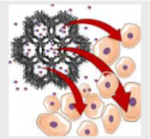
Materials for the controlled release of nitric oxide (NO) are of interest for therapeutic applications. However, to date, many suffer from toxicity and stability issues, as well as poor performance. Herein, we propose a new NO adsorption/release mechanism through the formation of nitrites on the skeleton of a titanium-based Metal-Organic Framework (MOF) that we have named MIP-177, featuring a suitable set of properties for such applications: (i) high NO storage capacity (3 μmol mg-1solid), (ii) excellent biocompatibility at therapeutic relevant concentrations (no cytotoxicity at 90 μg/mL for wound healing) due to its high stability in biological media (< 9% degradation in 72 hours) and (iii) slow NO release in biological media (⁓2 hours for 90% release). The prospective application of MIP-177 is demonstrated through the NO-driven control of mitochondrial respiration in cells and the stimulation of cell migration, paving the way for the design of new NO delivery systems for wound healing therapy.

Presse Release (in french): Un MOF à base de titane prometteur pour la cicatrisation !
References:
Tuning Cellular Biological Functions Through the Controlled Release of NO from a Porous Ti-MOF
Rosana V. Pinto, Sujing Wang, Sergio R. Tavares, João Pires, Fernando Antunes, Alexandre Vimont, Guillaume Clet, Marco Daturi, Guillaume Maurin, Christian Serre and Moisés L. Pinto
Angew. Chem. Int. Ed. 2020
DOI: 10.1002/anie.201913135
